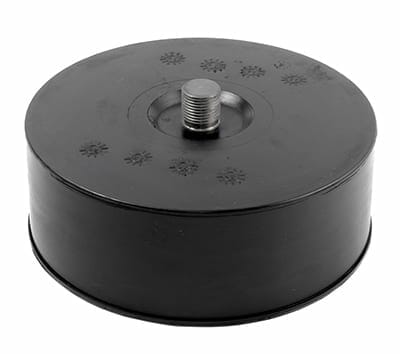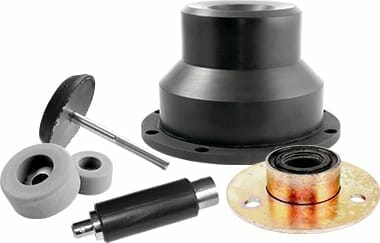Rubber to Metal Bonding
Insert Molding and Over Molding
Injection molding and transfer molding are the most efficient techniques for rubber-to-metal bonding. The choice of process depends on the application of the part, especially considering the intended use of the finished product. These methods are perfect for bonding rubber to metal and plastic components, such as gears, shafts, rollers, bumpers, and stops, available in a variety of sizes and shapes. Additionally, they are effective for attaching rubber elements to materials like steel, aluminum, brass, and plastic.
In addition to unmatched product quality, Qualiform’s knowledgeable technical staff can assist OEM design engineers with design consulting and selecting the correct rubber compounds. Our team can provide recommendations based on the performance requirements and part application. Our goal, with every project, is to produce uniform, high-quality products as efficiently as possible. As a result, we have developed customized rubber to metal molding and bonded solutions to meet customer requirements.
Qualiform – Your #1 Rubber Metal Molding Company
Qualiform outperforms all other rubber molding companies producing the largest, most complex parts in the industry. We also offer unparalleled experience in this process and are more than happy to consult on your rubber bonded to metal application.


Rubber to metal molding process used to create bumpers for trains.
The Rubber to Metal Bonding Process
Utilizing rubber injection molding and transfer molding processes to encapsulate and bond rubber to metal is the most effective way to adhere rubber to metal or plastic parts. Furthermore, the rubber to metal molding process provides a superior mechanical bond of rubber to metal parts and inserts or plastic parts.
Two-Step Process
The process requires a two-step preparation of the metal or plastic part prior to molding the rubber. First, we degrease and clean off any contaminants, similar to preparation for industrial coatings or painting. Once we finish cleaning, we spray a special, heat-activated adhesive onto the metal parts.
Once the part is ready for rubber overmolding, the metal parts are inserted into the mold cavity. If molding a specific area, the metal part is held in place by special magnets. If the part is to be completely encapsulated with rubber, the part is held in place with chaplet pins. The mold is then closed and the rubber molding process begins. As the elevated molding temperature cures the rubber, it also activates the adhesive forming a mechanical bonding of rubber to metal or bonding rubber to plastic.
Encapsulating with Rubber to Metal Bonding
When a metal or plastic part requires complete encapsulation with rubber, we use rubber insert molding, a variation of rubber to metal bonding. For complete encapsulation, the plastic or metal part is suspended inside the bold cavity, so we can more accurately bond the rubber to the part. Rubber can also be molded to a specific area of metal parts. Mechanically adhering rubber to metal can enhance the stability of metal parts with the flexible characteristics of rubber. Metal parts with molded rubber can also improve part properties such as creating environmental seals, meeting NEMA standards, electrical conductivity, noise and vibration isolation, wear and impact resistance, chemical and corrosion resistance and more.
Materials that can be insert molded, overmolded or bonded of a specific area include: steel, brass, aluminum, alloys, exotics, engineered resins and plastics.
Additionally, rubber bonded to metal ranges in parts and in size from small inserts to very large components. Overmolded rubber metal parts are applicable across a broad range of industries and applications.
Types of Rubber We Mold
Qualiform molds both natural rubber and synthetic rubber which include:
- Butyl
- Colored Compounds
- EPDM
- Natural Rubber
- Neoprene
- Nitrile
- SBR
- Viton™
- Fiber Molding

Rubber Molding FAQ’s
Qualiform Rubber Molding Company
Within the rubber molding industry, Qualiform is one of the top American rubber molding companies. We create each customer’s products using special compounds and unique designs, so we can meet their exact specifications. We also tackle specific molding challenge using problem-solving abilities we’ve acquired through comprehensive experience in rubber molding and rubber-to-metal molding or bonding.
Qualiform Quality Assurance Program
Qualiform Rubber Molding is an ISO 9001:2015. We commit to enacting the most effective quality assurance program. This selected program oversees, evaluates, and documents every part of our molding process. Thus, we are able to follow customer requirements and ensure customer satisfaction with all products and services that we offer.
Our Specialties
Qualiform services include custom rubber molding, custom rubber transfer molding, rubber parts manufacturer, custom rubber injection molding, custom rubber compression molding, rubber to metal molding and bonding, and rubber products manufacturer.
Questions?
Our technical staff is available to answer any questions call (330) 336-6777, or submit a question through our Contact Form or Send Us a PDF.


